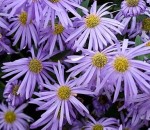 Thompson’s aster is a herbaceous perennial native to the western Himalyas. It is a member of the Asteraceae family that also includes sunflowers, daisies, and lettuce. Hairy stems carry dark green leaves that are three to four inches long, oval, and coarsely toothed. The flowerheads are one to two inches across and are carried in clusters on long slender stems beginning in late summer and lasting for a long bloom time into fall. Each flowerhead has lilac-blue ray flowers surrounding a center of yellow disc flowers and attracts bees and butterflies. The species is rarely seen in the garden having been replaced by its dwarf form ‘Nanus’ that is twelve to eighteen inches tall and has blue flowerheads one 1-1.5” across. ‘Nanus’ is an excellent choice for the front of the border and butterfly garden. The generic name Aster comes from the Latin word aster meaning star and refers to the form of the flowers. The specific epithet thomsonii honors the 19th century Scot botanist, Thomas Thomson, who was a surgeon in the Bengal Army and superintendent of the Calcutta Botanic Garden.
Thompson’s aster is a herbaceous perennial native to the western Himalyas. It is a member of the Asteraceae family that also includes sunflowers, daisies, and lettuce. Hairy stems carry dark green leaves that are three to four inches long, oval, and coarsely toothed. The flowerheads are one to two inches across and are carried in clusters on long slender stems beginning in late summer and lasting for a long bloom time into fall. Each flowerhead has lilac-blue ray flowers surrounding a center of yellow disc flowers and attracts bees and butterflies. The species is rarely seen in the garden having been replaced by its dwarf form ‘Nanus’ that is twelve to eighteen inches tall and has blue flowerheads one 1-1.5” across. ‘Nanus’ is an excellent choice for the front of the border and butterfly garden. The generic name Aster comes from the Latin word aster meaning star and refers to the form of the flowers. The specific epithet thomsonii honors the 19th century Scot botanist, Thomas Thomson, who was a surgeon in the Bengal Army and superintendent of the Calcutta Botanic Garden.
Type: Herbaceous perennial
Bloom: Flowerheads one to two inches across consisting of lilac-blue ray flowers surrounding a center of yellow disc flowers; in late summer into fall
Size: 1-3’ H x 2’ W
Light: Full sun to part shade
Soil: Average, medium moist, well-drained
Hardiness: Zones 4-9
Care: Cut back in fall after flowering; divide every three to four years
Pests and Diseases: Powdery mildew, aster wilt,
Propagation: Division, basal cuttings
Companion Plants: Rudbeckia ‘Goldsturm’, goldenrod, ornamental grasses
Outstanding Selections: ‘Nanus’ (12-18” H, blue flowerheads 1-1.5” across)